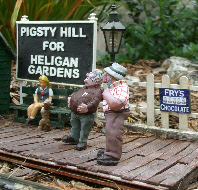
The Pigsty Hill Light Railway
I must admit that I was at a loss for a prototype for the new line until the summer of 2007, when I visited the lower terminus of the 2’6" gauge Pentewan Harbour, where one can still see a few tracks and ramps from which ships were loaded. While sheltering from the fierce Cornish sunshine, which threatened to penetrate my cagoule and rust up my camera, I decided to model the PHR’s extension through Heligan to Mevagissey.
In the 1890’s, the railway was faced with the increasing silting-
The route then followed an existing path into Mevagissey, where there was a Town
station, which is now, alas, a car park. A branch ran through the narrow streets
to the harbour, very much after the fashion of the W&LLR at Welshpool. This had the
dual function of exporting china clay and transporting fish to those up-
Map of the PHLR
This new line was built under a Light Railway Order and assumed the name of the Pentewan and Heligan Light Railway, although it was in practice completely controlled by the Pentewan Harbour and Railway Company. It is conjectured that the omission of Mevagissey from the railway's name was an attempt to prevent the GWR getting wind of the PHLR's designs on a desirable holiday resort. This turned out to be academic, as the locals christened it the 'Pigsty Hill Light Railway' almost from its opening day, and this name appeared in Bradshaw’s Railway Guide from 1895 onwards.
Incidentally, it was long thought that 'Pigsty Hill' was a named after the Tremayne estate's famous pigsties, home of the rare Cornish Blue breed, but it is likely that the name is much older. Recent archaeological research points to a Neolithic pig cult. The discovery of charred remains of pigs, in shallow pits among evidence of feasting, gives credence to this theory.
The line did important duty during both World Wars, although security prevented any
photography of its vital cargoes. By the end of the Great War, both locomotives,
‘Canopus’ and ‘Pioneer’, and most of the stock were worn out, and the future looked
bleak. However, by a happy chance, Lieutenant Colonel Arthur Tremayne of the Royal
Engineers, a director of the PHLR, returned from the war with knowledge of a brand
new geared 0-
After World War II, the forward-
In the mid 1950’s, much of the china clay traffic was redirected via standard gauge
lines to Par and Fowey but, for a while, things looked rosy with the increase in
post-
Sadly, the last train ran in 1961. If only it had survived a few more years, it would have made a delightful preserved line. How the good citizens of Mevagissey would prefer the ‘emmet dilly’ to today’s traffic jams!
There has recently been much talk of re-
However, all is not lost. It is now possible to walk the line almost in its entirety. Cornwall County Council’s ‘Coast and Clay Trail’ faithfully follows the trackbed from Carthew to Mevagissey via St Austell and Pentewan, with a short deviation around Heligan Gardens.
The Pigsty Brewery and its Railway
Anyone old and lucky enough to have visited Cornwall in the 1950's will remember the products of the Pigsty Brewery; Old Boar Bitter and Old Sow Cider were a regional, nay national, institution in that county. The brewery was established in 1898 by Nigel Trewithen of Cheesewarne Farm, soon after the opening of the Pigsty Hill Light Railway's Mevagissey Extension. In fact, it was unusual in being dependent on rail transport from its inception, there being very limited road access to the site.
It is believed that the PBR was the inspiration behind the Oakhill Brewery Railway
in Somerset, opened in 1904, although this only lasted a few years until 1921. During
this brief period, the line was operated on the same push-
In 1961, the closure of the PHLR, which linked Pigsty Hill with St Austell and the
rest of Cornwall, tolled the death knell for the brewery, and St Austell Ales bought
out its goodwill and its public houses. Indeed, they brewed Old Boar Bitter right
up into the 1980's, although old-
Origins of the Railway
The Pigsty Brewery Railway existed solely to link the Pigsty Brewery to the PHLR
at Pigsty Hill station. Because of the availability of second-
When the line was first constructed, trains (and, worse, their smoke) were visible from Heligan House, spoiling the Tremayne family's view of Pigsty Hill and St Austell Bay. In those days, the local landowner's word was law, and something had to be done. The obvious solution was to run the line around behind Pigsty Hill, but there was insufficient room there to take both the PBR's track and that of the PHLR.
At the request of the chairman of the Pigsty Brewery, officers of the PHLR and Pigsty
Brewery met to discuss a proposal that a section of the former should be converted
to mixed gauge, with running rights for the PBR on the two-
The PBR was to have its own bay platform at Pigsty Hill, with cross platform transfer of goods and a smart new yard crane.
It might seem strange that the PHLR board was so easily swayed, given the costs involved.
Cynics might take note that the meeting was held at the Pigsty Brewery, after a sumptuous
meal and comprehensive beer-
Rolling stock
Initially the PBR purchased two small 0-
The working vehicles were two 4-
Realising the Dream
I decided that Pigsty Hill station would be the perfect prototype, with Heligan House Halt a few scale yards away for a later project. It was of particular interest, exporting exotic fruit and vegetables and importing coal and other necessities for the house, as well as visitors to the Gardens. Passing trains carried tourists, fish, china clay and general goods.
After all, if one is modelling a railway in a garden, why not model a railway in a garden? It also didn’t escape my notice that Mevagissey quay would be a perfect setting for my tiny indoor line, but that’s another story.
I decided to model the railway as it was in the early 50’s, when a healthy mineral and fish traffic was still being carried, and when the tourist traffic was at its height. It suits my existing locos and stock and gives me the excuse to build, beg or borrow a railbus, a project that has been much on my mind.
This autumn, I had the pleasure of walking the trackbed of the PHLR. I was delighted
to find the sole remaining building of the old Pentewan Harbour Railway, a china
clay store in the Co-
The final extent of the PHLR can be seen on “The PHLR and the GWR” page at Maps and the layout on “PHLR Mark V”.
NOTE: This page is based on articles I wrote for Garden Rail magazine. See Garden Rail Index to find my articles
...
Author’s confession
Much of this history is imaginary, but it might well have happened. The Pentewan
Harbour Railway was real, and most of it can be walked today. After sketching out
my legend, I re-
The Pigsty Brewery is, alas, pure fiction.
The Pigsty Hill Light Railway -
The History of the Prototype
An Unreliable History of the PHLR in the Real World









